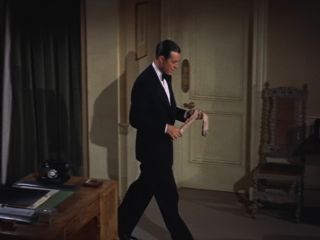The MacGuffin: News and Comment (12/Apr/2008)
(c) Ken Mogg (2008)
April 12
Although Hitchcock's fine film of Dial M for Murder (1954) made almost no major changes from the Frederick Knott play that had recently been so successful in London and New York, it did sometimes put emphases differently. One such change in emphasis concerns the current feelings of the married Margot Wendice for crime writer Mark Halliday (called Max Halliday in the play). In the play, it's clear that, despite her passionate affair with Max a year ago (which had continued by correspondence), she now wants to keep her marriage to Tony Wendice alive, and for Max to remain just a friend. But the film depicts things differently. From the moment we see Margot - in a red dress - and Mark kissing, at the start of the film, it's clear that their relationship remains passionate on both sides. (The euphony of their respective names, Margot and Mark, subtly underlines this.) Interestingly, the film is sometimes less emphatic than the play about certain things, especially where this helps to keep audience-sympathy for retired tennis player Tony Wendice. For example, the play spells out that Tony always intended to marry for money. 'I had to', he tries to excuse himself - referring to the taste for the high life that being a tennis champion, who had travelled three times around the world, gave him. He had almost married 'a tubby Boston deb with five million dollars', but 'she threw me over for an heir to a chain of grocery stores'. Fortunately for Tony, the rich Margot had then turned up - she 'had been a fan of mine for some time'. In the film, we're given none of this detail. We simply hear Tony say, 'I know I did [marry for money]', whereupon he pauses thoughtfully, just long enough to raise the possibility that he may have regrets. Reading the play, you also notice things like how the film has streamlined some business. To enable Tony to steal Margot's key from her purse (and then leave it under the stair-carpet for the hired killer, Swann), the play includes an elaborate episode in which Max and Margot disappear into the kitchen to make paste for Margot's clippings; the film simply has Tony manipulate the key from her purse while requesting some loose change (business possibly inspired by another film involving a key, Hitchcock's Notorious). On the other hand, the film has its suspenseful stag-party scene at Tony's club, which the play doesn't have; the pay-off for the film, apart from the suspense, is that we can see Tony tell Mark to stay behind at the club - which in the play is something that hangs unexplained for a while. But of course the play is a brilliant piece of stage-craft. Here's one crucial detail I noticed this week when I read the play. Swann attempts to strangle Margot with his scarf, which he has brought with him for the purpose. The play includes this note: 'This scarf must have tassel ends, to emphasize, later, that it is a scarf and must be silk and tan colored so that Margot could mistake it for a stocking.' Naturally Hitchcock's film gets this important detail right. In the frame-capture below, Tony has recovered the scarf from near Swann's body (who was killed by Margot in self-defence) and is about to destroy it before the police arrive; in place of it, he'll substitute one of Margot's own stockings, to make the police suspect that she had hastily planted this intended murder-weapon (supposedly) of Swann's while all along having intended to kill him with scissors after inviting him to the apartment. Oh, and in the same frame-capture notice one of the apartment's two Chippendale chairs. As Steven Jacobs points out in his book 'The Wrong House: The Architecture of Alfred Hitchcock' (2007), the Wendices have a cultivated taste in artworks, including these two chairs - which are practically doubles of the two chairs that figure in another Hitchcock film about wife-killing, Suspicion (1941).
This material is copyright of Ken Mogg and the Hitchcock Scholars/'MacGuffin' website (home page) and is archived with the permission of the copyright holder. |

